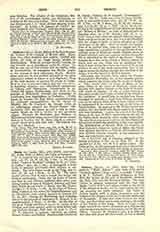

Cedes (or CADES; Heb., QDSH, Qedesh, sanctuary; Gr., Kad?s, Kades or Kedes), two cities of Palestine.
(I) A Levitical city and place of refuge in Nephtali (Jos., xix, 37; xx, 7; xxi, 32; 1 Par., vi, 76), hence called “Cedes in Nephtali” (Judges, iv, 6), or “Cedes in Galilee” (Jos., xx, 7, etc.), to distinguish it from Cedes in Issachar and Cades (Heb. Qedesh) in the Negeb. The form Cades occurs in the Vulg. only in Jos., xii, 22, and I Mach., xi, 63, 73. The name would indicate that it was a sacred city before the Hebrew occupation. Cedes was the home of Barac, and here he and Debbora gathered their army, consisting mainly of men of Nephtali, Zabulon and Issachar, before giving battle to Sisara, near Mt. Thabor (Judges, iv, 6, 10 sq.; v, 15). In the reign of Phacee, King of Israel, it was taken by Theglathphalasar and its inhabitants were carried captives to Assyria (IV K., xv, 29). During the Machabean wars Jonathan defeated the generals of Demetrius II, Nicanor, in its neighborhood (I Mach., xi, 63-74). At the time of the great Jewish rebellion it was in the hands of the Tyrians, and Titus camped under its walla before taking Gischala (Joseph., Bell. Jud., II, xviii, 1; IV, ii, 3). In Josephus it appears variously as Kedes?, Kedasa, Kadasa, and Kudasa. Eusebius calls it Kudissos, St. Jerome, Cidissus (in de Lagarde, “Onomastica,” 271, 53; 110, 8). Cedes was a city of Upper Galilee, close to and north of Asor (Jos., xix, 37; IV K., xv, 29; I Par., vi, 76; I Mach., xi, 63, 67-73; Joseph., Ant., V, i, 18, 24; IX, xi, 1; XIII, v, 6, 7). As the latter lay in the neighborhood of Lake Huleh, the Biblical “Waters of Merom” or Lake of Semechonitis of Josephus (Jos., xi, 1-10; Joseph., Ant., V, v, 1), Cedes cannot have been far distant from its shores. There can be no doubt, then, that it is to be identified with the village of Qades or Qedes, situated on a hill northwest of the lake. Here are found the foundations of an ancient wall, ruins of a temple and of a large mausoleum, a number of fine specimens of sarcophagi, some of which are double, besides pieces of broken columns, bases and capitals, scattered over the hill or imbedded in the walls of the houses. These remains show that in the Greek or Roman period, to which they are due, Cedes was an important city. Such it must always have been by reason of its strong position on one of the trade routes from Tyre to the regions across the Jordan, though after the time of the Judges it hardly figures in Hebrew history.
Exception has recently been taken by Conder, Hummelauer, Zanecchia, etc., to the common opinion which connects this Cedes with the events of Judges, iv. They would place the home of Barac at another Cedes, in the south of Nephtali, which they identify with Khirbet Qadish on the Lake of Genesareth, south of Tiberias. A city of Cedes existing at this point would throw light on some of the details of the narrative. It would help to explain how Barac managed to assemble a large force without interference on the part of Jabin, King of Asor, which is hard to understand if the rendezvous was at the Cedes of Upper Galilee. Its nearness to Mt. Thabor would also explain why the battle with Sisara came to be fought near that mountain. Lastly, the arrival of the flying Sisara at the tent of Jahel, apparently on the day of the battle itself, would be more readily understood. The only direct argument, however, for the existence of this second Cedes is the similarity of the name Qadish. The identification of Sennim (Heb. Ca anannim or Beca anannim), where the tents of Haber the Cinite were pitched, with Sinn-en-Nabrah (Hummelauer) or with Khirbet Bessum (Conder) is too uncertain to base any conclusions upon it.
(2) A Levitical city of Issachar assigned to the family of Gersom (I Par., vi, 72—Heb. 57). In the parallel list of Jos., xxi, 28 it is called Cesion. The Cades of Jos., xii, 22, commonly held to be Cedes in Galilee, is by some identified with this Cedes of Issachar.
F. BECHTEL

